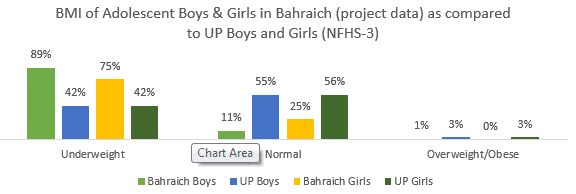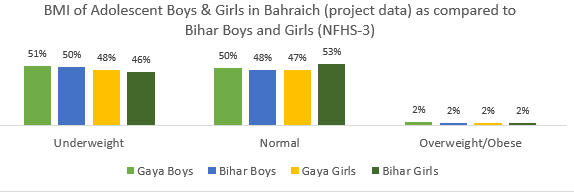Supporting India’s ‘Poshan Abhiyaan’ to Improve Adolescent Nutrition
February 4th, 2019 | viewpoint
India is the sixth largest and fastest growing economy in the world. While we have the world’s third highest number of billionaires, we are also home to an astounding 190 million undernourished people, the highest in the world, leading to a loss of nearly 4% of India’s GDP[1]. India is also home to 253 million adolescents, a majority of whom have low BMI and are anemic. According to national data 41.9% girls and 44.8% boys between 15-19 years are underweight (BMI <18.5) while 54% girls and 29% boys are anemic[2].
In recent times, the government of India has taken progressive steps, such as the launch of a nation-wide Poshan Abhiyaan or National Nutrition Mission, to address under-nutrition and anemia[3]. To support the government’s efforts, JSI R&T India Foundation in partnership with NGO SHARP launched ‘Project ANSH’ in one district of Uttar Pradesh(UP), Bihar, Assam, and Madhya Pradesh with financial support from GSK Consumer Health under their Corporate Social Responsibility (CSR) program.
ANSH aims to reach 150,000 rural adolescents to improve their Body Mass Index (BMI) and reduce Anemia through a multi-pronged strategy to improve nutritional literacy & WASH practices, strengthen nutrition services, and promote consumption of fortified foods and weekly Iron Folic Acid (IFA) supplementation among adolescents.
In two of the larger districts, Bahraich district of UP and Gaya district of Bihar, a core group of 2000 school-going and 400 non-school going adolescents is being more intensely counselled to adopt healthy nutrition practices using one-to one and group counselling methodologies. They will receive regular follow-up to document the changes in their behavior and in their nutrition parameters to generate evidence and learning for further scale-up.
A project baseline survey of the above mentioned core group of adolescents (10-19 years) was done in Oct-Nov 2018, to capture their BMI (calculated as Weight/Height in meters2). A BMI of 18.5-24.9 is considered normal while anything below and above is underweight or overweight respectively.
As seen in Figure 1, the Bahraich survey yielded poorer status than UP averages (NFHS 3), with 89% boys and 75% girls underweight. The difference between the two genders was significant. A very small proportion of children were overweight.

With 51% boys and 48% girls underweight (figure 2), the situation among adolescents of Gaya district was better than Bahraich but very similar to Bihar averages. A mere 2% of children were overweight.

Overall, the survey data indicates that the nutritional status of adolescents in Bahraich is substantially poorer than estimated through national surveys and worse for boys than girls. The sudden growth spurt among boys may be the underlying factor. As the project progresses, we will document nutrition and WASH practices of the adolescents of this region in an attempt to identify factors that may be responsible for the current situation.
Currently, the project is in the process of connecting with adolescents who have been identified as having a low BMI to enroll them in regular interpersonal and group counselling sessions on nutrition and hygiene. In the near future, we will also document the Hemoglobin status of the core group of children with the aim to initiate targeted interventions for those with anemia to raise their HB status.
[1] ASSOICHAM-EY Joint paper http://www.timesofindia.com
[2] National family Health Survey -4, MOHFW
[3] Nourishing India, National Nutrition Strategy, Niti Aayog, 2017
Written by Amrita Misra, Ashok Kumar, Abhishek Anand, and Ranajit Sengupta
We strive to build lasting relationships to produce better health outcomes for all.